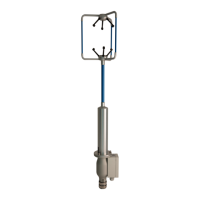WindMaster and WindMaster Pro 1561-PS-0001. Issue 11 February 2017
________________________________________________________________________________________________________________________
6
3. PRINCIPLE OF OPERATION
Figure 1 Time of Flight details
The WindMaster measures the times taken for an ultrasonic pulse of sound to travel from an upper transducer to the
opposite lower transducer, and compares it with the time for a pulse to travel from lower to upper transducer.
Likewise times are compared between each of the other upper and lower transducers.
As Figure 1 shows, the air velocity along the axis between each pair of transducers can then be calculated from the
times of flight on each axis.
This calculation is independent of factors such as temperature.
From the three axis velocities, the wind speed is calculated, as either signed U, V, and W, or as Polar and W.
It can be seen from Figure 1 that the speed of sound in air can be calculated from the times of flight. From this the sonic
temperature can be derived from the formula T
S1 =
C
1
2
/ 403
Where
T
S1
=
Sonic temperature
C
1
= Speed of sound
Note the formula does not account for the effect of Humidity
Crosswind correction is applied to results.

